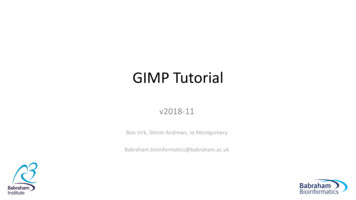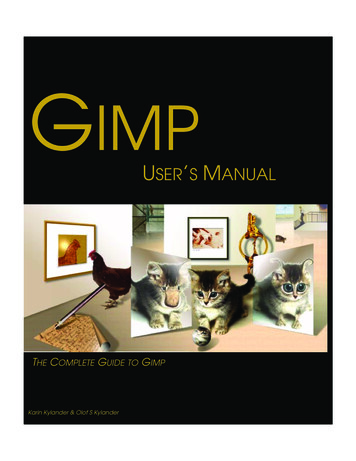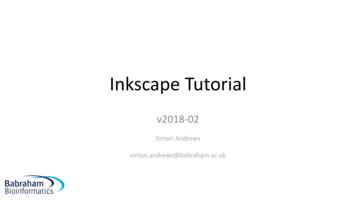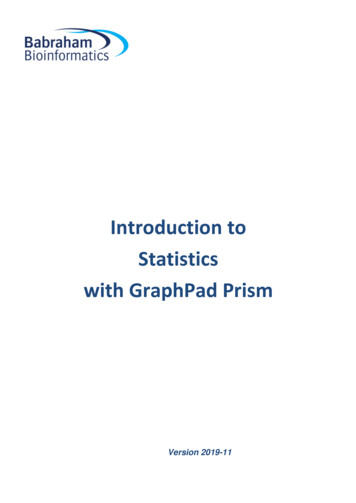
Transcription
GIMP Tutorialv2018-11Boo Virk, Simon Andrews, Jo MontgomeryBabraham.bioinformatics@babraham.ac.uk
What is GIMP GNU Image Manipulation ProgramBitmap Graphics EditorOpen SourceCross Platformwww.gimp.org Not for Vector editing
Vector vs Bitmap
Getting GIMPwww.gimp.org Open Source Cross Platform
Basic Layout View Toolbox – Windows New toolbox or (Ctrl B) View Layers Dialogue box – Windows Dockable Dialogs Layers or (Ctrl L) GIMP can do a lot of things – will show you small selection oftools that are ethically acceptable to use for figure production
Opening Images To open an image for editing:– Drag file onto a new GIMP windowor– File Open or (Ctrl O) After opening, save a working copy of the file GIMP saves files as XCF files by default, but you canexport files in other formats (e.g. PNG)
Straightening Images Drag a horizontal guide line onto your image (from top ruler)to intersect an area that should be perfectly horizontal Using the ‘Rotate’ tool(Shift R) rotate the image sothat it lines up with the guideline When you start to rotate the image, a dialogue box willappear
Straightening Images When finished click the rotate button to apply To remove guideline: Image Guides Remove all Guides
Cropping Images Useful to crop unnecessary edges away Can reduce file size when bringing images into avector file Use the ‘Rectangle Select’ tool (R) to draw a boxaround the area of the image you want to keep
Cropping ImagesDon’t forgetabout Ethics! Click and drag the corners of the box after drawing tofine tune Crop: Image Crop to Selection
Brightness and ContrastIncreasing BrightnessIncreasing Contrast
Brightness and Contrast Adjusting brightness and contrast can help the clarity of your image In GIMP,– Colours Brightness-Contrast If a selection box is marked, brightness and contrast will be adjusted inselected area only
Brightness and ContrastOriginalBrightness andContrast adjustedBrightness andContrast adjustedtoo muchUnethicalimage isoversaturated
Colour Levels Brightness and contrast should be edited byadjusting colour levels– Colors LevelsOr: Dialogue box shows histogram of colour value usage– Useful to display a Logarithmic histogram so thatvalues aren’t hidden at the bottom of the graph
Colour LevelsDisplayLogarithmicHistogramThe middle handle willadjust the midpoint ofthe levels andrepresents non-linearediting of colours.This is not ethicallyacceptable forpublication!
Alpha channel Alpha channels are masks through which you candisplay images Within an alpha channel:– White acts as the visible area– Black acts as the transparent area– Level of gray in between determines the level ofvisibility.
Why use an alpha channel?250250200200150150100100505000
In GIMP– Layer Transparency Add Alpha Channel
Colour to Alpha Channel You can assign a colour to the alpha channel, which will makeall pixels in your image with the assigned colour transparent In GIMP– Colors Color to AlphaPreview, indicatingwhich areas are to betransparentUse this tool to panaround the previewColour swatch – forselecting colour tobecome transparent
Pseudo-colour OverlaysSome experiments such as FISH microscopy maygenerate multiple greyscale images which can beoverlaid to form a pseudo-colour image
Pseudo-colour Overlays Ensure image is inRGB mode– Image Mode RGB Assign a single colourto each image (v2.8)– Color Colorify
Pseudo-colour Overlays Ensure image is in RGBmode– Image Mode RGB Assign a single colour toeach image (v2.10)– Help Search and Run acommand– “Colorify”ColorifyReplace all colors withshades of a specified color
Or Colors Levels Dial down the colours you don’t want
Pseudo-colour Overlays Once images are correct colours, we need to overlaythem Open Layers dialogue box (if not already open)– Windows Dockable Dialogues Layers– (Ctrl L)
Click and drag image layer in to the working windowof another image Repeat this until one image has all of the desiredlayers
Finally, make each layer (except the bottom layer)show only its colour, making the underlying layersvisible– Layer Dialogue Box - Mode ‘Lighten Only’
15/10/2019Creating Scientific Figures
Scaling Images GIMP can be used to scale the size of your image– Image Scale ImageAvoid making your imagesbigger than original size,bitmaps do not scale upwell!
Exporting Images Once editing is done, andthe working XCF file issaved, you need to exportthe image File Export As Specify file format e.g. PNG Always save your image asa PNG file, maintainstransparency (alphachannel) and is lossless
GIMP saves files as XCF files by default, but you can export files in other formats (e.g. PNG) Straightening Images Drag a horizontal guide line onto your image (from top ruler) to intersect an area that should be perfectly horizontal Using the ‘Rotate’ tool (Shift R) ro










